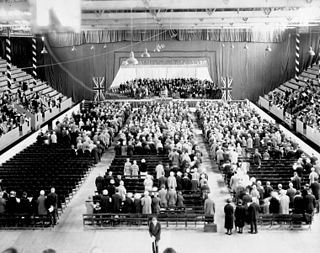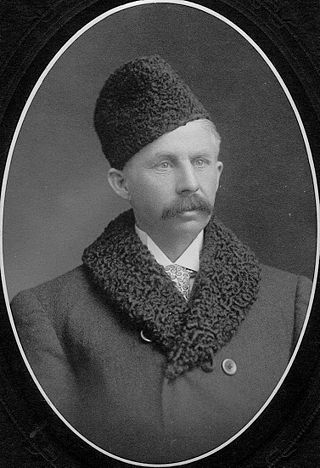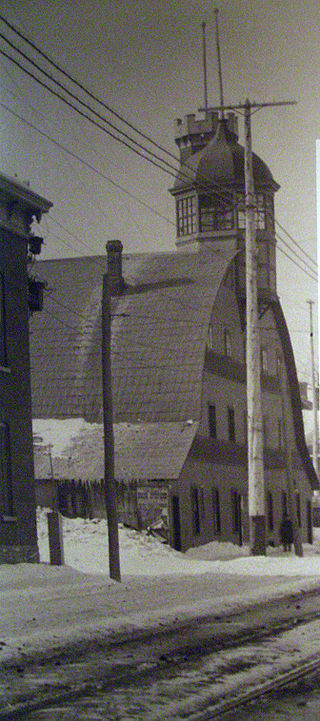
Mutual Street Arena, initially called Arena Gardens or just the Arena, was an ice hockey arena and sports and entertainment venue in Toronto, Ontario, Canada. From 1912 until 1931, with the opening of Maple Leaf Gardens, it was the premier site of ice hockey in Toronto, being home to teams from the National Hockey Association (NHA), the National Hockey League (NHL), the Ontario Hockey Association (OHA) and the International Hockey League (IHL). It was the first home of the Toronto Maple Leafs, who played at the arena under various names for their first 13½ seasons. The Arena Gardens was the third rink in Canada to feature a mechanically frozen or 'artificial' ice surface, and for eleven years was the only such facility in eastern Canada. In 1923, it was the site of the first radio broadcast of an ice hockey game, the first radio broadcast of an NHL game, and the first broadcast of an ice hockey game by long-time broadcaster Foster Hewitt.

Maple Leaf Gardens is a historic building located at the northwest corner of Carlton Street and Church Street in Toronto, Ontario, Canada. The building was originally constructed in 1931 as an indoor arena to host ice hockey games.

TD Place Arena, originally the Ottawa Civic Centre, is an indoor arena located in Ottawa, Ontario, Canada, seating 6,500 people. With temporary seating and standing room it can hold 8,000 people. Opened in December 1967, it is used primarily for sports, including curling, figure skating, ice hockey and lacrosse. The arena has hosted Canadian and world championships in figure skating and ice hockey, including the first women's world ice hockey championship in 1990. Canadian championships in curling have also been hosted at the arena. It is also used for concerts and conventions such as Ottawa SuperEX.

The Kitchener Memorial Auditorium Complex is a multi-use municipally-owned facility in Kitchener, Ontario, Canada. The complex is located on East Avenue, near the Ottawa Street interchange on the Conestoga Parkway. The complex includes "The Kitchener Memorial Audiorium" with the Dom Cardillo Arena, two smaller community arenas the Kinsmen Arena and Kiwanis Arena, the Jack Couch Stadium baseball park, Centennial Stadium and a skatepark outside the stadium.

The Sudbury Community Arena is a multi-purpose arena in the downtown core of Greater Sudbury, Ontario, Canada. It was built in 1951, on the site of the former Central Public School, at a cost of $700,000. The approval and construction of the arena was overseen by Sudbury Mayor Bill Beaton. It is home to the Sudbury Wolves of the Ontario Hockey League.

The Ottawa Auditorium was a 7,500-seat arena located in Ottawa, Ontario. It was located in Downtown Ottawa at the corner of O'Connor and Argyle Streets, today the site of the Taggart Family YMCA. Built primarily for ice hockey, the arena was also used for sports events, assemblies and musical concerts.
Dey's Arena, also known as Dey Brothers Rink, Dey's Skating Rink and The Arena, were a series of ice rinks and arenas located in Ottawa, Ontario, that hold importance in the early development of the organized sport of ice hockey in Canada. It was the home arena of the Ottawa Hockey Club, variously known as the Generals, the Silver Seven and the Senators from the 1890s until 1923, although it is known that games were also played at the Rideau Skating Rink in the 1890s and the Aberdeen Pavilion in 1904. The rink and arenas were built by two generations of the Dey family, who were prominent in Ottawa at the time, with a thriving boat works business serving the lumber business. The Dey family also played hockey.

Denman Arena was an indoor arena located in the West End neighbourhood of Vancouver, British Columbia. The arena was located at 1805 West Georgia Street at the northwest corner with Denman Street. It opened in December 1911 and was destroyed by fire in 1936. Its primary use was for ice sports such as ice hockey. It was the home ice rink of the Vancouver Millionaires professional ice hockey team, and was the location of 1915 Stanley Cup championships. The arena was also used for other sports, musical performances and public assemblies. It was an assembly point for Canadian servicemen during World War I. The 10,500-seat arena was the largest in Canada at the time, and introduced mechanically frozen or "artificial" ice to Canada.

Shea's Amphitheatre, also known as the Winnipeg Amphitheatre, was an indoor arena located in Winnipeg, Manitoba, Canada. It seated 6,000 spectators.

Edwin Peter Dey was a boat-builder, ice arena owner, and hockey team owner. He was an owner of the Ottawa Senators men's ice hockey club from 1917 until 1923. He and his brothers Frank Edgar Dey and William Ernest Dey built the various Dey's Arenas where the Senators played until 1922–23.

The Victoria Skating Rink was an indoor ice skating rink located in Montreal, Quebec, Canada. Opened in 1862, it was described at the start of the twentieth century to be "one of the finest covered rinks in the world". The building was used during winter seasons for pleasure skating, ice hockey and skating sports on a natural ice rink. In summer months, the building was used for various events, including musical performances and horticultural shows. It was the first building in Canada to be electrified.

The Toronto Professional Hockey Club was a professional ice hockey team in Toronto, Ontario, Canada. It was Toronto's first professional ice hockey team, founded in 1906. The team played the 1906–07 season in exhibition games against other professional teams. In 1908, the team was one of the founders of the Ontario Professional Hockey League (OPHL). The club operated for two seasons in the OPHL, 1908 and 1909, before disbanding. The club challenged unsuccessfully for the Stanley Cup in 1908. They were usually referred to as the Toronto Argonauts.

The Rideau Skating Rink was an indoor skating and curling facility located in Ottawa, Ontario, Canada. Consisting of a curling rink and a skating rink, it was one of the first indoor rinks in Canada. The Rideau Rink was scheduled to open on January 10, 1889, but unseasonably mild weather postponed the grand opening to February 1. It opened on January 25, 1889 for select V.I.P.s although this was a misunderstanding and should not have denied entry to season ticket holders. It was located on Theodore Street, at Waller Street, at the present location of the Arts Hall of the University of Ottawa, near the Rideau Canal.

The Granite Club is a private social and athletic club in Toronto, Ontario, Canada. Founded in 1875, it has a long history of sports competition. It is located at 2350 Bayview Avenue, north of midtown Toronto.

The Arena, also known as Dey's Arena was an arena for ice hockey located in Ottawa, Ontario, Canada. It was the home of the Ottawa Hockey Club from 1908 to 1923. It was the third in a series of ice hockey venues built by the Dey family of Ottawa. At the time of its building, it was Canada's largest arena.

John Purcell Quinn was a Canadian athlete, businessman, sports executive and politician. He was an owner and president of the Toronto Blueshirts, winners of the Stanley Cup in 1914. He was a member of the world champion Montreal Shamrocks lacrosse team in 1896. From 1927 until 1932 and 1937 until 1942 he served as alderman on Toronto City Council. His brother Emmett Quinn was also an ice hockey executive.

The St. Nicholas Rink, also called the St. Nicholas Arena, was an indoor ice rink, and later a boxing arena in New York City from 1896 until 1962. The rink was one of the earliest indoor ice rinks made of mechanically frozen ice in North America, enabling a longer season for skating sports. It was demolished in the 1980s.

The Winnipeg Auditorium was an indoor arena in Winnipeg, Manitoba, Canada. It was the premier site for ice hockey in Winnipeg from the time of its construction in 1898. The Auditorium rink hosted several Stanley Cup championship series. It was located at the intersection of Garry Street and York Avenue. It was destroyed by fire in 1926.
The Grand National Rink was an outdoor skating rink located in the Brockton Village neighbourhood of Toronto, Ontario, Canada from 1896 to 1902. At the time, it was the largest open-air rink in the city. Its location is now the site of the McCormick Playground Arena at McCormick Park in the Little Portugal neighbourhood.

















